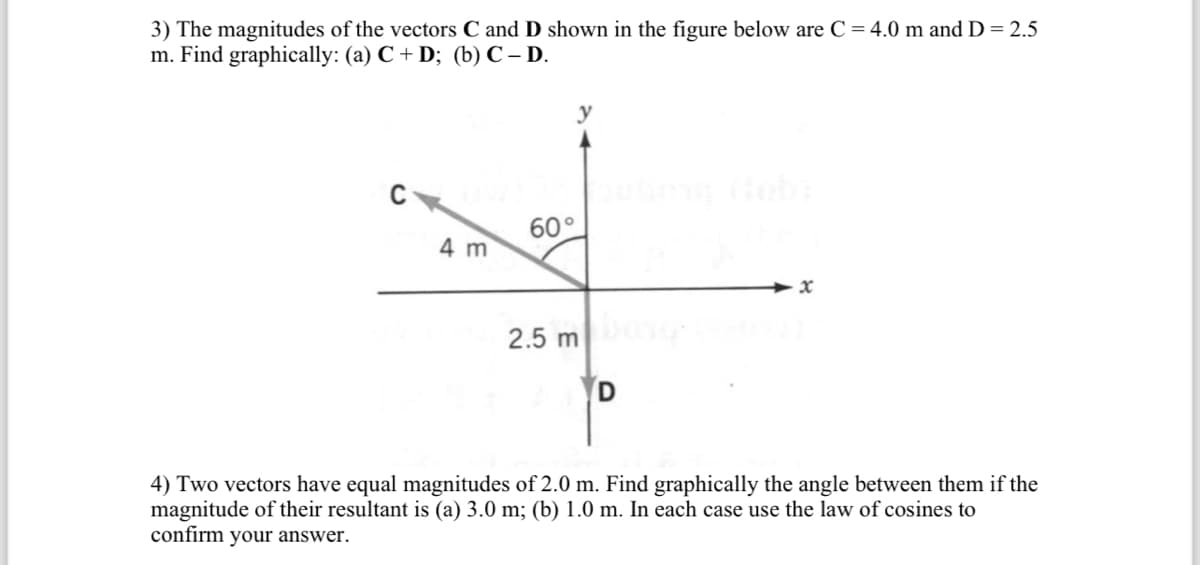3) The magnitudes of the vectors C and D shown in the figure below are C = 4.0 m and D = 2.5 m. Find graphically: (a) C + D; (b) C-D. C 4 m y 60° 2.5 m D x 4) Two vectors have equal magnitudes of 2.0 m. Find graphically the angle between them if the magnitude of their resultant is (a) 3.0 m; (b) 1.0 m. In each case use the law of cosines to confirm your answer.
3) The magnitudes of the vectors C and D shown in the figure below are C = 4.0 m and D = 2.5 m. Find graphically: (a) C + D; (b) C-D. C 4 m y 60° 2.5 m D x 4) Two vectors have equal magnitudes of 2.0 m. Find graphically the angle between them if the magnitude of their resultant is (a) 3.0 m; (b) 1.0 m. In each case use the law of cosines to confirm your answer.
Physics for Scientists and Engineers with Modern Physics
10th Edition
ISBN:9781337553292
Author:Raymond A. Serway, John W. Jewett
Publisher:Raymond A. Serway, John W. Jewett
Chapter3: Vectors
Section: Chapter Questions
Problem 9P: The displacement vectors A and B shown in Figure P3.9 both have magnitudes of 3.00 m. The direction...
Related questions
Question
4) Two vectors have equal magnitudes of 2.0 m. Find graphically the angle between them if the magnitude of their resultant is (a) 3.0 m; (b) 1.0 m. In each case use the law of cosines to confirm your answer.
Problems 3 and 4 are graphical solutions. Please use a protractor, ruler, and compass and work as accurately as possible. Alternatively, you could use a vector drawing program to work out the geometry

Transcribed Image Text:3) The magnitudes of the vectors C and D shown in the figure below are C = 4.0 m and D = 2.5
m. Find graphically: (a) C + D; (b) C-D.
C
4 m
y
60°
2.5 m
D
x
4) Two vectors have equal magnitudes of 2.0 m. Find graphically the angle between them if the
magnitude of their resultant is (a) 3.0 m; (b) 1.0 m. In each case use the law of cosines to
confirm your answer.

Transcribed Image Text:Problems 3 and 4 are graphical solutions. Please use a protractor, ruler, and compass and
work as accurately as possible. Alternatively, you could use a vector drawing program to
work out the geometry.
1) A stone released at the top of the shaft of a well hits the water 1 55 s later (a) How deen is
Expert Solution
This question has been solved!
Explore an expertly crafted, step-by-step solution for a thorough understanding of key concepts.
Step 1: 3) Determine the given data:
VIEWStep 2: (a) Find graphically C+D:
VIEWStep 3: (b) Find graphically C-D:
VIEWStep 4: 4) Determine the given data:
VIEWStep 5: Determine the angle between the vectors when their resultant is 3:
VIEWStep 6: Determine the angle between the vectors when their resultant is 1:
VIEWSolution
VIEWStep by step
Solved in 7 steps with 12 images

Knowledge Booster
Learn more about
Need a deep-dive on the concept behind this application? Look no further. Learn more about this topic, physics and related others by exploring similar questions and additional content below.Recommended textbooks for you

Physics for Scientists and Engineers with Modern …
Physics
ISBN:
9781337553292
Author:
Raymond A. Serway, John W. Jewett
Publisher:
Cengage Learning

Physics for Scientists and Engineers
Physics
ISBN:
9781337553278
Author:
Raymond A. Serway, John W. Jewett
Publisher:
Cengage Learning

College Physics
Physics
ISBN:
9781285737027
Author:
Raymond A. Serway, Chris Vuille
Publisher:
Cengage Learning

Physics for Scientists and Engineers with Modern …
Physics
ISBN:
9781337553292
Author:
Raymond A. Serway, John W. Jewett
Publisher:
Cengage Learning

Physics for Scientists and Engineers
Physics
ISBN:
9781337553278
Author:
Raymond A. Serway, John W. Jewett
Publisher:
Cengage Learning

College Physics
Physics
ISBN:
9781285737027
Author:
Raymond A. Serway, Chris Vuille
Publisher:
Cengage Learning

Principles of Physics: A Calculus-Based Text
Physics
ISBN:
9781133104261
Author:
Raymond A. Serway, John W. Jewett
Publisher:
Cengage Learning

University Physics Volume 1
Physics
ISBN:
9781938168277
Author:
William Moebs, Samuel J. Ling, Jeff Sanny
Publisher:
OpenStax - Rice University

Glencoe Physics: Principles and Problems, Student…
Physics
ISBN:
9780078807213
Author:
Paul W. Zitzewitz
Publisher:
Glencoe/McGraw-Hill